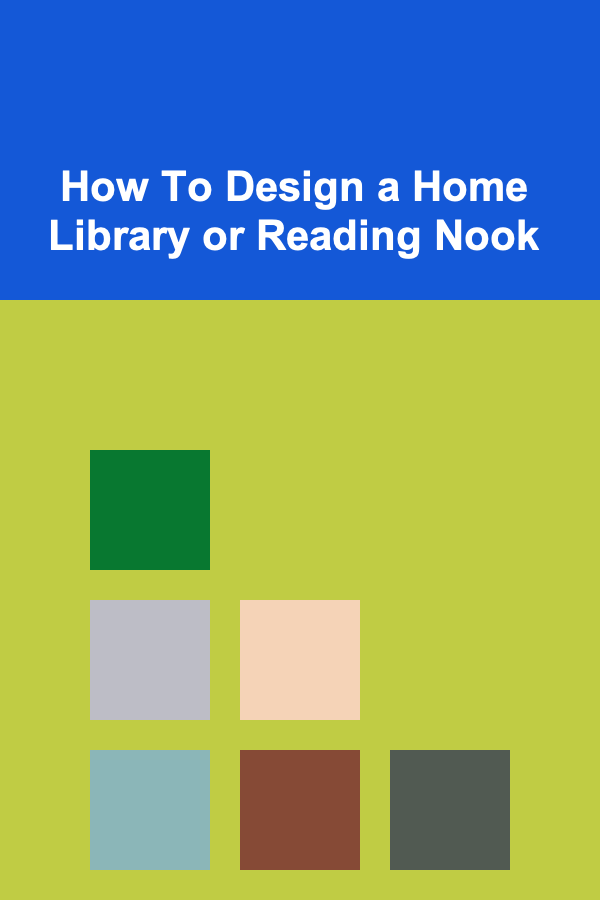
How To Design a Home Library or Reading Nook
ebook include PDF & Audio bundle (Micro Guide)
$12.99$10.99
Limited Time Offer! Order within the next:

Designing a home library or reading nook is a rewarding project that brings personal comfort, intellectual stimulation, and aesthetic beauty to your living space. Whether you are an avid reader, a casual book lover, or simply looking to create a peaceful retreat, a well-designed library or reading nook can become a treasured sanctuary. In this article, we will explore how to approach the design of these spaces, focusing on functionality, aesthetics, and how to make the most of the space you have.
Understanding the Purpose of a Home Library or Reading Nook
Before you begin planning the design of your home library or reading nook, it's essential to consider its purpose. While both spaces are intended for reading, they may differ based on your personal needs and the type of atmosphere you wish to create.
- Home Library: A home library is generally a larger space dedicated to housing an extensive collection of books, often designed to serve as both a functional area for reading and a storage space for your collection. It may also serve as a multi-purpose room where you can entertain guests, study, or work on projects.
- Reading Nook: A reading nook, on the other hand, is a smaller, more intimate space designed specifically for relaxation and reading. It can be as simple as a cozy corner in a living room or a secluded alcove by a window.
By understanding the function of each space, you will be able to design it in a way that suits both your practical and emotional needs.
Location and Layout
The first step in designing a home library or reading nook is determining its location within your home. The right location will not only provide the optimal conditions for reading but also complement the overall design of your home.
Choosing the Right Location
- Home Library: If you are creating a full-fledged home library, the space should ideally be quiet and away from high-traffic areas of the house. Consider rooms that have minimal distractions, such as basements, attics, or spare rooms. Large windows that allow natural light are a plus, but artificial lighting should be incorporated to ensure you can read comfortably at any time of day.
- Reading Nook: A reading nook can be placed in a variety of locations, depending on the space available. A corner by a large window, a cozy alcove in a hallway, or even under a staircase can make for a charming nook. The key is to select a spot that feels intimate and comfortable, away from distractions and noise.
Optimizing Layout for Functionality
- Seating Arrangements: The seating arrangement is one of the most important considerations for both a library and a reading nook. Comfortable seating encourages long reading sessions. A traditional library might benefit from an armchair or a sofa, while a reading nook could feature a built-in bench, a soft lounge chair, or a bean bag.
- Bookshelves: For a home library, bookshelves should be the centerpiece of the space. Floor-to-ceiling shelves are ideal for maximizing storage, but they should also be accessible and organized in a way that suits your needs. For a reading nook, you may not need extensive shelving, but a small shelf or wall-mounted storage can still house your current reading materials.
- Storage Solutions: If you are designing a home library, think about how to best store your books and other materials. Custom shelves, rolling carts, and closed cabinets are all great options that allow you to keep everything organized without creating a cluttered environment.
Lighting Design
Proper lighting is crucial in any home library or reading nook, as it directly impacts your ability to read comfortably and the overall ambiance of the space.
Natural Light
Maximize the natural light in your space by placing your reading nook near windows or skylights. Exposure to natural light has been shown to improve mood and focus, making it ideal for a reading environment. If you are designing a home library, large windows that allow natural light to flood the room will also help create a warm, inviting atmosphere.
However, it's important to manage natural light effectively to avoid glare on your books or screen, especially during the afternoon when sunlight is at its peak.
Artificial Lighting
When it comes to artificial lighting, you need layers to create the right atmosphere. A combination of ambient, task, and accent lighting works best.
- Ambient Lighting: This provides general illumination and helps fill the room with light. Ceiling-mounted lights, such as recessed or track lighting, work well for large library spaces. For smaller nooks, consider a table lamp or floor lamp that casts light from above.
- Task Lighting: For reading, task lighting is key. Desk lamps, adjustable reading lamps, or wall sconces are essential for providing directed, focused light where you need it most. The light should be bright enough to reduce eye strain, but not so harsh that it disrupts the relaxing atmosphere of your space.
- Accent Lighting: Accent lighting helps highlight certain features, such as bookshelves or artwork. It can also create a cozy, intimate ambiance. LED strips along shelves or spotlights to illuminate specific sections of the room can add visual appeal without overwhelming the space.
Furniture and Decoration
The furniture and decoration in your home library or reading nook should promote comfort and enhance the atmosphere of the space. Since this area will likely be used for long periods of time, it's essential to invest in quality, ergonomic furniture.
Comfortable Seating
- Reading Nook: In a small reading nook, consider comfortable and ergonomic seating options such as a plush armchair, a chaise lounge, or even a window seat with cushions. Make sure the seating offers proper support for your back and legs. You might want to include throw blankets or pillows for extra coziness.
- Home Library: For a full library, seating options may vary depending on the space available. A combination of armchairs, sofas, and ottomans creates versatility, allowing you to read, work, or entertain in the space. Add a table for drinks or reading materials to make the space even more functional.
Shelving and Book Storage
Bookshelves are the focal point of any home library. For a reading nook, a small bookshelf or cart can hold the books you're currently reading, while the library may feature built-in shelves, wall-mounted units, or freestanding bookshelves.
Consider the material and style of the shelves. Wood is classic and warm, while metal or glass might suit a modern aesthetic. Floating shelves can create a minimalist look, while traditional bookcases provide a more classic library feel.
Decorative Elements
To make the space feel inviting, add personal touches through artwork, rugs, and accessories. A large rug beneath your reading chair can help define the area and add warmth to the space. Incorporate plants for a touch of nature and freshness. For the home library, you can also add artwork, framed quotes, or antique bookends to give the room a curated, personalized look.
Color Scheme and Materials
The colors and materials you choose for your library or reading nook will set the tone for the space. While personal preference plays a role, certain color schemes and materials are better suited to creating a peaceful, conducive environment for reading.
Color Palette
- Neutral Tones: Light, neutral colors such as whites, grays, and soft blues help create a calm and focused atmosphere. Neutral tones are especially ideal for a home library, as they don't distract from the books themselves.
- Warm Tones: If you want to create a cozy and intimate vibe, warm colors like browns, mustard yellows, or soft reds work well. These tones make the space feel inviting and comfortable, which is perfect for a reading nook.
- Accent Colors: You can add pops of color through pillows, rugs, or artwork. Consider earthy greens, muted golds, or deep blues, which can add warmth and sophistication without overwhelming the space.
Materials
The materials you choose will also affect the overall look and feel of the space. Wood, velvet, leather, and cotton are all great options for creating a luxurious and comfortable reading environment. For a modern or industrial look, you might opt for metal or glass for bookshelves and other furniture pieces.
Acoustic Considerations
Especially if your home library or reading nook is in a busy area of your home, consider adding soundproofing elements. Soft fabrics, thick curtains, and upholstered furniture can absorb sound and make the space quieter. This can create an environment more conducive to focus and relaxation.
Personalizing the Space
A home library or reading nook is meant to be a personal sanctuary. Make sure to personalize the space with items that reflect your style, interests, and reading habits. Display your favorite books, art pieces, or memorabilia. Consider how the space will evolve with your collection and taste over time.
Personal Touches
- Bookshelves and Book Display: Arrange your books in a way that feels meaningful to you. You can organize them by genre, color, or author. Some people enjoy the creative freedom of mixing their book collections with decorative items, while others prefer a more streamlined look.
- Accessories: Add comfortable throw blankets, stylish pillows, or decorative rugs that reflect your personality. If you enjoy writing, a small desk or writing nook might complement your reading area.
Technology Integration
For some, integrating technology into the home library or reading nook may enhance the experience. Consider installing a sound system for background music or audiobooks. A smart speaker can be handy for playing relaxing sounds, while an e-reader or tablet might be a good addition for those who prefer digital reading.
Conclusion
Designing a home library or reading nook is an exciting opportunity to create a personal retreat where you can escape into your favorite books and find peace. By carefully considering the location, layout, furniture, lighting, and materials, you can build a space that fosters both relaxation and productivity. Whether you're a book collector or simply seeking a cozy corner to unwind, a well-designed library or reading nook can enrich your home and your reading experience for years to come.

How to Create a Checklist for Reviewing and Updating Company Policies After Offboarding
Read More
How to Sell Handmade Pottery on Etsy: A Comprehensive Guide
Read More
How to Tidy Up Your Home in 30 Minutes or Less
Read More
Transform Your Business with Advanced Digital Marketing Tactics: Insights from a Digital Marketing Manager's Desk
Read More
Understanding Job Descriptions: Decoding Employer Needs
Read More
How To Exercise Your Right to Object to Processing
Read MoreOther Products

How to Create a Checklist for Reviewing and Updating Company Policies After Offboarding
Read More
How to Sell Handmade Pottery on Etsy: A Comprehensive Guide
Read More
How to Tidy Up Your Home in 30 Minutes or Less
Read More
Transform Your Business with Advanced Digital Marketing Tactics: Insights from a Digital Marketing Manager's Desk
Read More
Understanding Job Descriptions: Decoding Employer Needs
Read More